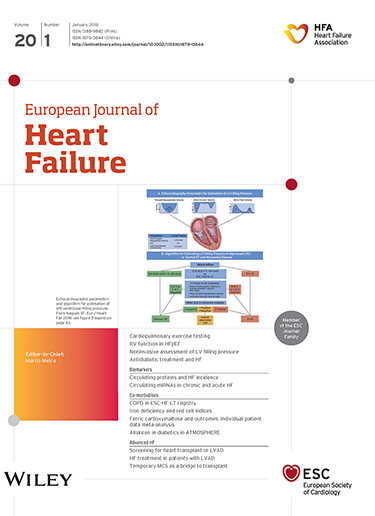Incidence of major cardiovascular events in patients with metabolic dysfunction-associated steatotic liver disease in the general population.
IF 10.8
1区 医学
Q1 CARDIAC & CARDIOVASCULAR SYSTEMS
引用次数: 0
Abstract
AIMS Major adverse cardiovascular events (MACE) related to cardiovascular disease are a major cause of death in patients with metabolic dysfunction-associated steatotic liver disease (MASLD). We explored the impact of MASLD on incident MACE and overall mortality in the general population in Germany. METHODS AND RESULTS A total of 14 575 patients were included for the analysis. Elevated liver enzymes were present in 21.7% and MASLD, defined with a positive fatty liver index (FLI) in the absence of relevant alcohol use, was detected in 37% of participants. MACE were defined as a three-item composite endpoint of acute myocardial infarction (AMI), stroke and cardiovascular mortality (3-point MACE) and extended MACE (eMACE) including MACE criteria, incident atrial fibrillation and pulmonary embolism. In the group with a positive FLI (≥60) a higher rate of male sex and a higher age as well as a higher prevalence of metabolic and cardiovascular risk factors compared to the group with a negative FLI (<30) were present. At 5 years of follow-up, 475 patients (3.7%) developed 3-point MACE and 577 (4.9%) developed eMACE. In the subgroup with MASLD, the incidence of eMACE was higher (7.1% vs. 3.7%; p < 0.0001). Using Cox regression analysis with a stepwise adjustment strategy, we were able to show an independent prediction of MACE and eMACE by hepatic steatosis under consideration of various confounders. The presence of MASLD was associated with an increased risk of developing MACE by 62.3% (p < 0.0001) and eMACE by 44.0% (p < 0.0001). Importantly, MASLD was associated with an increased risk for all-cause mortality (hazard ratio 1.55; p < 0.0001). CONCLUSIONS Metabolic dysfunction-associated steatotic liver disease is an independent risk factor for MACE and is associated with a significantly increased risk of all-cause mortality. In the management of patients with cardiovascular risk, identification of MASLD can potentially refine their disease trajectory.普通人群中代谢功能障碍相关脂肪变性肝病患者主要心血管事件的发生率
目的:与心血管疾病相关的主要不良心血管事件(MACE)是代谢功能障碍相关脂肪变性肝病(MASLD)患者死亡的主要原因。我们探讨了MASLD对德国普通人群MACE事件和总死亡率的影响。方法与结果共纳入14 575例患者进行分析。21.7%的参与者存在肝酶升高,37%的参与者检测到MASLD,即在没有相关酒精使用的情况下脂肪肝指数(FLI)呈阳性。MACE被定义为急性心肌梗死(AMI)、卒中和心血管死亡率(3点MACE)和扩展MACE (eMACE)的三项复合终点,包括MACE标准、房颤事件和肺栓塞。在FLI阳性组(≥60)中,与FLI阴性组(<30)相比,男性比例更高,年龄更高,代谢和心血管危险因素的患病率也更高。随访5年,475例(3.7%)发生3点MACE, 577例(4.9%)发生eMACE。在MASLD亚组中,eMACE的发生率更高(7.1% vs. 3.7%; p < 0.0001)。使用Cox回归分析和逐步调整策略,我们能够在考虑各种混杂因素的情况下,显示肝脏脂肪变性对MACE和eMACE的独立预测。MASLD的存在与发生MACE的风险增加62.3% (p < 0.0001)和eMACE风险增加44.0% (p < 0.0001)相关。重要的是,MASLD与全因死亡风险增加相关(风险比1.55;p < 0.0001)。结论:代谢功能障碍相关的脂肪变性肝病是MACE的独立危险因素,并与全因死亡率的显著增加相关。在心血管风险患者的管理中,MASLD的识别可以潜在地改善他们的疾病轨迹。
本文章由计算机程序翻译,如有差异,请以英文原文为准。
求助全文
约1分钟内获得全文
求助全文
来源期刊

European Journal of Heart Failure
医学-心血管系统
CiteScore
27.30
自引率
11.50%
发文量
365
审稿时长
1 months
期刊介绍:
European Journal of Heart Failure is an international journal dedicated to advancing knowledge in the field of heart failure management. The journal publishes reviews and editorials aimed at improving understanding, prevention, investigation, and treatment of heart failure. It covers various disciplines such as molecular and cellular biology, pathology, physiology, electrophysiology, pharmacology, clinical sciences, social sciences, and population sciences. The journal welcomes submissions of manuscripts on basic, clinical, and population sciences, as well as original contributions on nursing, care of the elderly, primary care, health economics, and other related specialist fields. It is published monthly and has a readership that includes cardiologists, emergency room physicians, intensivists, internists, general physicians, cardiac nurses, diabetologists, epidemiologists, basic scientists focusing on cardiovascular research, and those working in rehabilitation. The journal is abstracted and indexed in various databases such as Academic Search, Embase, MEDLINE/PubMed, and Science Citation Index.
 求助内容:
求助内容: 应助结果提醒方式:
应助结果提醒方式:


